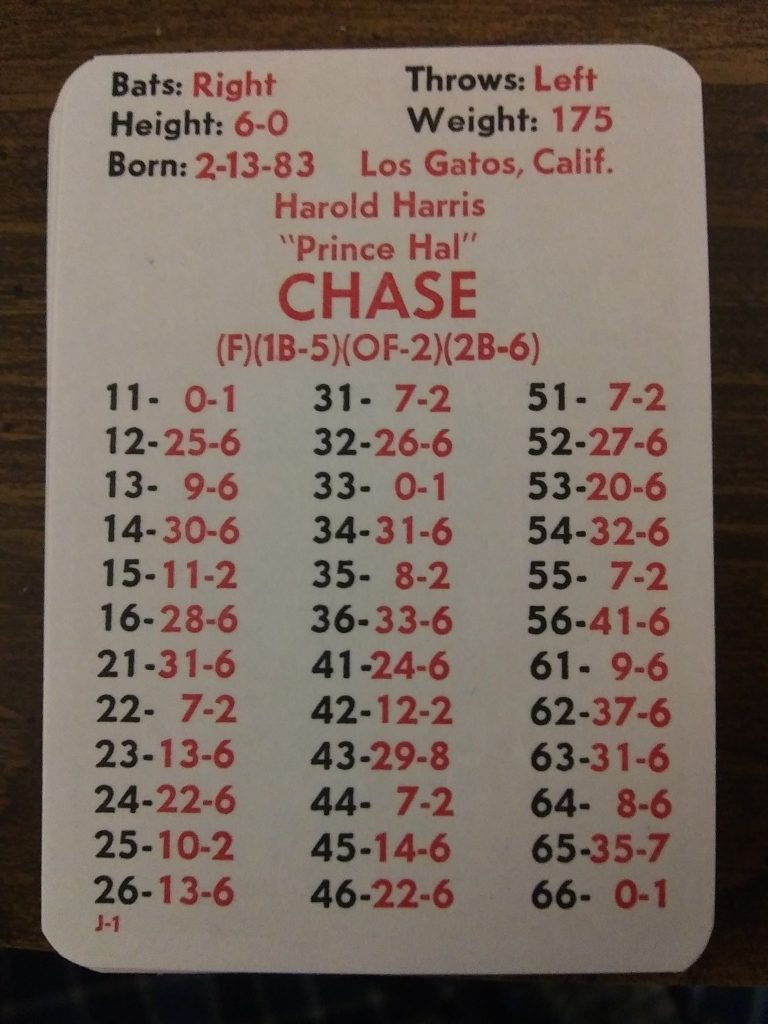
I was looking for a good Monday card today and Charles Cox comes through with a great one he posted on Facebook. I have not seen this 1916 Harold “Hal” Chase APBA card before and it’s a fantastic deadball card.
Hal Chase had come to the Cincinnati Reds from the defunct Federal League in 1916 and must have learned a thing or two. Batting .339, he led the National League (note: I don’t know why Baseball Reference’s embedded stats below have him at .341).
Chase also led the NL in hits with 184. His middle name was Homer but he only managed to go yard four times. Prince Hal did lead the team with 22 stolen bases.
| Split | G | GS | PA | AB | R | H | 2B | 3B | HR | RBI | SB | BB | SO | BA | OBP | SLG |
|---|---|---|---|---|---|---|---|---|---|---|---|---|---|---|---|---|
| 1916 Totals | 142 | 133 | 572 | 543 | 67 | 185 | 29 | 12 | 4 | 84 | 23 | 19 | 49 | .341 | .364 | .460 |
There’s lots to unpack with this card but let’s start with the fact that Hal Chase is a deadball player so him having three zeroes is doing all right in the power department. While he only has three ones in the second column, check out how many twos he has. I am counting nine! Only two singles out there as well.
Chase has a 15-11 and a 25-10 to replicate his 22 stolen bases in 572 plate appearances. Normally, 11s and 10s preclude the appearance of 7s on an APBA card but Chase has a total of five (22, 44, 55, 51 and 31). While this seems a high amount for someone who batted .339 keep in mind that he only walked 19 times. As a result, he only has one 14 at 45. That might explain the very unusual 13-9.
I count a grand total of two thirteens on 1916 Hal Chase’s card. No doubt he was taunted by the other ballplayers for being a “whiffer”.
Hal Chase has three 31s. He might be someone to consider to hit and run with.
Another rarity: 1916 Chase has two 22s one at 24 and one at 46. This card must have been published before the advent of the 42.
By all reports, Hal Chase was one of the best fielding firstbasemen of his time. This is definitely reflected in his fielding rating of 1B-5.
One last thing… this APBA card set places the 12 at 42. Looking at the APBA 12 List, I can tell the set was published in 1980 when the 12 was placed in a different dice roll number each year. That would drive me nuts since 42 is generally a good number (and also explains why Chase’s hit numbers extend so far). Back in those days, my friend Don would joke, “Why doesn’t APBA put the 12 at 66? I never roll those.”
Now of course, the 12 has a permanent home at dice roll 23.
For more info on one of the best (and corrupt) firstbaseman of the era, check out B-R’s bio on him.
Thanks Charles! A very interesting card for Monster Monday!




So, you discern that this set came out in 1980, yet you still believe it must have come out before the advent of the 42, which first appeared in the 1971 set?
(Chase was hit by just one pitch in 1916. More likely the 22s are there because, except for with a runner at first, it is an error or rare play. Deadball sets often had multiple such numbers.)
Another nice article Tom.
I also agree with Jason above. That looks like a fun card to play with.